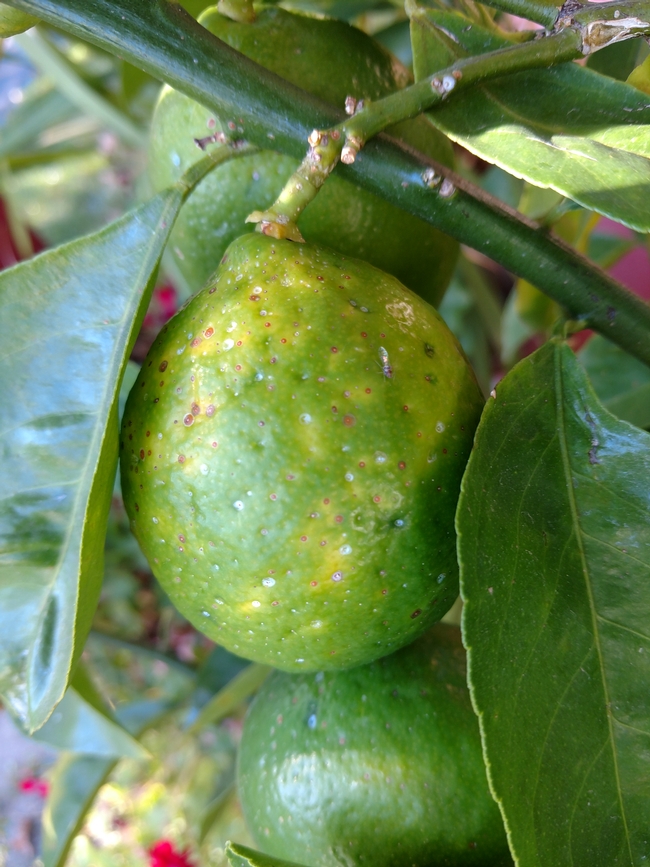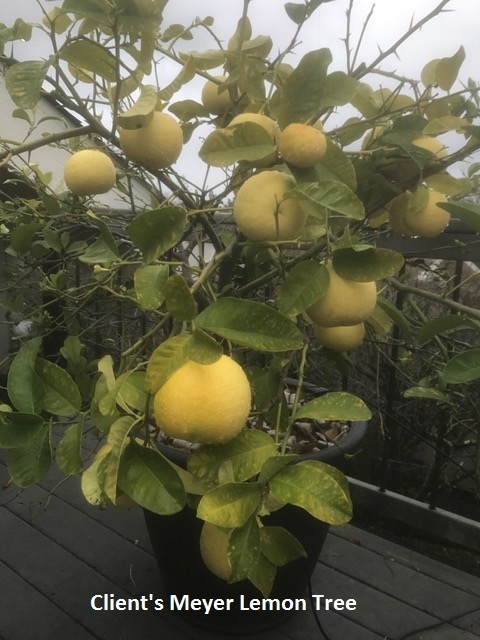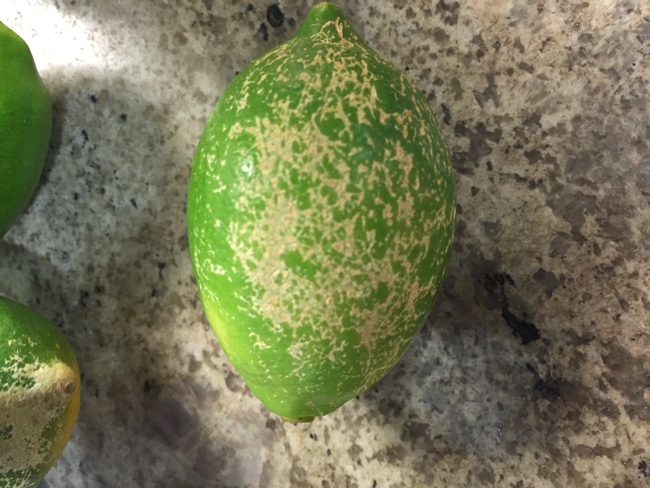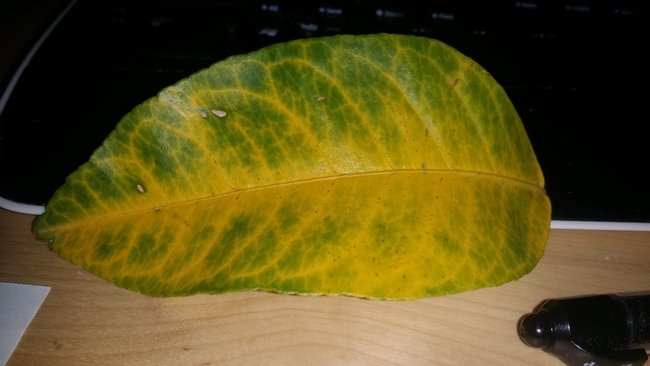Advice for the Home Gardener from the Help Desk of the
UC Master Gardener Program of Contra Costa County

UC MG Help Desk Response: Thank you for contacting the UC Master Gardener Program Help Desk about the problem with your citrus and also thanks for sending that great picture as it allows for a clear diagnosis. Your citrus is infected with scale – but don't worry, scale can be managed.
Scale is an insect that sucks on plant juices. Left unchecked it could cause damage to or reduce the vigor of your plant. Regarding whether the quality of your fruit will be impacted - I don't believe so. The problem with the scale on the rinds is that it is primarily unsightly. If you were going to leave the rind on for your use of the fruit then you would want to scrub the surface to remove the scale bodies..
The scale on your citrus stems and fruit is an armored scale. From your picture I am unable to identify the particular species of armored scale but that does not matter because management would be the same.
What you see residing on your plant are females and immature who do not have wings and therefore simply reside there – feeding.
Understanding the basic life cycle will help to understand the pest management practices:
Adult females produce eggs that are usually hidden under their bodies. Eggs hatch into tiny crawlers (immatures) which settle down and begin feeding within a day or two after emergence. Settled immatures may spend their entire life in the same spot without moving as they mature into adults.
Chemical treatments are most effective when the crawlers are just emerging in spring. See the link at the end of the narrative (below) for additional information on monitoring when crawlers are crawling.
Management:
Provide plants with good growing conditions and proper cultural care, especially appropriate irrigation, so they are more resistant to scale damage. You can prune off heavily infested twigs and branches, if they are limited to a few parts of small plants.
Horticultural oil is effective in spring or summer on deciduous plants when sprayed soon after most crawlers have emerged and most scales are in the young immature stage. Late spring and summer are also the times to spray avocado, citrus, and many other broadleaf evergreens. Horticultural oil kills the scales through suffocation.
Where plants can be sprayed, complete spray coverage of infested plant parts with horticultural oil at the proper time provides good control of most scales. Horticultural oils (e.g., Bonide Horticultural Oil and Monterey Horticultural Oil) are specially refined petroleum products, often called narrow-range, superior, or supreme oils.
Other non-persistent, contact sprays for garden include insecticidal soap (e.g., Safer Brand Insect Killing Soap Concentrate II), neem oil (Bayer Advanced Natria Neem Oil Concentrate, Green Light Neem, Garden Safe Brand Neem), canola oil (Bayer Advanced Natria Multi-Insect Control), and other botanical (plant-derived) oils.
Thoroughly cover with spray the plant parts where scales occur, typically on twig terminals and the underside of leaves. Follow the product label with respect to target plant, timing etc. Do not apply oil or other insecticides when it is foggy, freezing (under 32°F), hot (over 90°F), when relative humidity is above 90%, or if rain is expected in the next 24 hours. Especially at locations with hot weather, be sure plants are well irrigated before spraying foliage.
Below is a link to the UC Integrated Pest Management website that provides additional information on Scale lifecycle and management.
Armored scale do not produce honey dew (a sugar based excrement) so disregard the information about monitoring honeydew and controlling ants.
http://ipm.ucanr.edu/PMG/PESTNOTES/pn7408.html
Help Desk of the UC Master Gardener Program of Contra Costa County (EDC)
Note: UC Master Gardeners Program of Contra Costa's Help Desk is available almost year-round to answer your gardening questions. Except for a few holidays (e.g., last 2 weeks December), we're open every week, Monday through Thursday for walk-ins from 9:00 am to Noon at 2380 Bisso Lane, Concord, CA 94520. We can also be reached via telephone: (925) 608-6683, email: ccmg@ucanr.edu, or on the web at http://ccmg.ucanr.edu/Ask_Us/. MGCC Blogs can be found at http://ccmg.ucanr.edu/HortCoCo/ You can also subscribe to the Blog (//ucanr.edu/blogs/CCMGBlog/)
Advice from the Help Desk of the
UC Master Gardener Program of Contra Costa County
Client's Request: What do you think caused my lemons to be too big (Picture 1). The second picture has a normal size Meyer lemon next to my too big Meyer lemon. All the lemons on the tree this year were like this. Last year most of the lemons were normal size except for three. The tree is about 8 to 10 years old. It's always been in the same pot on my deck. I fertilize it about three times a year. I appreciate any advice you can give me.

Response from the MGCC's Help Desk: Thank you for contacting the UC Master Gardener Program Help Desk with your question about your Meyer's lemon. It was a pleasure to talk to you in order to find out a bit more about your dwarf Meyer Lemon that has over-sized lemons with thick rinds and little juice.
After completing some research, reviewing the photograph of your 10 year old potted plant, and learning more about your fertilizing and irrigation routines, we have some information and suggestions to share with you that we hope you will find helpful.
Fruit Left on the Tree Too Long
Lemons may develop thick, puffy skin when left on the tree for too long after they ripen. You can wait to pick until the lemons have turned fully yellow, but to ensure juiciness and thinner skins, pick them while there is a little green still on the fruit.
Environmental Moisture and Watering
Dry weather or infrequent watering may cause your lemons to have a dry pulp. Water stress may prompt the tree to absorb moisture from the fruit's pulp, resulting in lemons with little juice. This reabsorption may also occur if you leave the lemons on the tree too long after they ripen. To prevent water stress, keep the top 5 to 6 inches of the soil moist; for dwarf lemons grown in a container, keep the top 1 to 2 inches of soil moist. Alternatively, excessive moisture in the air from high humidity levels may cause puffy rinds with a coarser texture and duller color, though the amount of juice may not be affected.
It's Time to Repot your Meyer Lemon
It is probably time to repot your Meyer Lemon. Potted lemon trees require repotting every two to three years, or when the roots begin growing out the drainage holes. The best time to repot your tree is in spring during heavy growth so it has time to establish in the new container.
Select a container one size larger than the current container. For example, upgrade from a 5 gallon to a 7-gallon pot or a 7-gallon to a 15-gallon pot.
Fill the new pot one-fourth full with a potting soil similar to the type used in the old container. Water the soil until it's evenly moist and the excess just begins to drain from the bottom.
Insert a trowel or knife between the soil and pot sides to loosen the root ball from the container. Grasp the tree near its base and lift it up while a second person pulls the pot downward.
Thoroughly examine the roots and locate any roots that are completely encircling the root ball. Slice through these roots with a clean knife; otherwise, they may constrict the root ball as they grow and cause the tree to die. Remove any dead root material.
Set the tree in the new pot. Adjust the depth of the soil beneath the root ball so the top of the root system sits 2 inches beneath the pot rim. The top of the roots should be just beneath the soil surface, and crown roots (root collar area) should show above the soil line.
Fill in around the roots with additional soil until the lemon tree is potted at the same depth it was at previously. Water thoroughly so the soil settles around the roots and add more soil, if necessary.
Possibly Over Fertilizing Your Tree
Most mature citrus require regular fertilization with nitrogen. Your fertilizer should have more nitrogen (N) than phosphorous (P) or potassium (K). Use at least a 2-1-1 ratio. Typically, most other nutrients are available in sufficient amounts in the soil. Nitrogen should be applied in January or February just prior to bloom. The second application then can be applied in May and perhaps a third in June. Avoid late-season fertilization as it may affect fruit quality, delay fruit coloring, and make the rind tough. Dwarf plants or trees in containers with restricted root space may require less fertilizer. Be careful not to over-fertilize as this could cause excessive new growth, which makes trees susceptible to other disorders.
Here is a list of citrus care articles that you may find helpful for the continuing health of your tree:
http://homeorchard.ucanr.edu/Fruits_&_Nuts/Citrus/
http://ipm.ucanr.edu/PMG/GARDEN/FRUIT/citrus.html
http://ucanr.edu/blogs/slomggarden/blogfiles/4260.pdf
We certainly hope this information is helpful to you. Please do not hesitate to contact us again should you have any other questions about your lemon tree or other horticultural needs.
Help Desk of the Master Gardener Program of Contra Costa County (WHM /SLH)
Note: The UC Master Gardeners Program of Contra Costa's Help Desk is available year-round to answer your gardening questions. Except for a few holidays, we're open every week, Monday through Thursday for walk-ins from 9:00 am to Noon at 75 Santa Barbara Road, 2d Floor, Pleasant Hill, CA 94523. We can also be reached via telephone: (925) 646-6586, email: ccmg@ucanr.edu, or on the web at http://ccmg.ucanr.edu/Ask_Us/ MGCC Blogs can be found at http://ccmg.ucanr.edu/HortCoCo/ You can also subscribe to the Blog (http://ucanr.edu/blogs/CCMGBlog/).
Advice from the Help Desk of the
UC Master Gardener Program of Contra Costa County
MGCC Help Desk Request:I am located in Central County. I am having issues with my lemon tree. I have attached some photos. I was hoping you could give me some advice.
I have never sprayed pesticides. I am hoping for a more organic solution to the issues. I know it might not be possible.
I have not fertilized it this year. It is on our sprinkler system so it gets water daily. Some of the leafs have spiderweb looking substance under the leafs. Some leafs are yellow. I have also noticed the spikes are very large. Thank you so much for your help.


MGCC Help Desk Response: Thank you for contacting UC Master Gardener Program with your lemon tree questions and for sending the photos. The symptoms you are seeing could be the result of various minor problems that occur on citrus. The curled leaves show signs of citrus leaf miner. Citrus leaf miners are moth larvae that create shallow tunnels in young leaves. They can distort the leaves but are generally not harmful to the tree. You are probably seeing the end result of leaf miner damage that was done previously. For more information on citrus leaf miners, see: http://ipm.ucanr.edu/PMG/PESTNOTES/pn74137.html.
We are not sure about the spiderweb type substance. It could be from an insect, e.g., whiteflies, but if so you should also find sticky areas on the leaves. Also, any pictures of the insect would be helpful. It is also possible that there are spiders on your tree. If that is the case, I would not worry. If you want the spider identified, see if you can get a photo and we will try to identify it.
The fruits look like they may have been damaged by the thorns which you indicated are very large. That would happen if the fruits were rubbing against the thorns. Is that possible? If not, another possibility would be herbicide damage. Is it possible that herbicides were used anywhere near the citrus tree? Even your neighbors? Make sure you remove the damaged fruits from the tree before we have any more rain. The damaged areas provide an opening for fungi and other diseases to get into the tree. Also, large thorns might indicate that the branch is a juvenile branch or is coming from below the graft, the "bump" near the bottom of the trunk. If from below the graft, you should consider removing that branch as it probably will not produce edible fruit.
The spots on the leaves may be from a fungus. The fungus may be the result of the watering, especially if the sprinkler system is putting water on the leaves. Make sure that the sprinkler is set low and also make sure that the sprinklers are not dampening the tree trunk. Wet tree trunks can lead to root or crown rot from fungus growing around the roots and crown (where the roots and trunk meet). Root and crown rots are serious diseases that are difficult to treat and can ultimately kill the tree.
The daily sprinkling may also be causing other problems for the overall health of your tree. Daily watering might not be supplying the citrus with enough water. Citrus, like most trees, do best with less frequent, and deep watering to promote stronger roots. To give you an example of how infrequent the watering should be, watering in the heat of summer should be done about every seven to ten days. This would be for citrus planted in the ground and with several inches of mulch under the tree out to drip line. In a pot you would need more frequent watering as they dry out faster. If other plants on your irrigation system need frequent watering, you should consider setting up a separate irrigation system on a different timer for the lemon. For more information on watering citrus, see: http://ipm.ucanr.edu/PMG/GARDEN/FRUIT/CULTURAL/citruswatering.html.
You mentioned that you had not fertilized the tree this year. Yellow leaves are a common sign of a lack of nitrogen. Citrus trees require regular fertilization, especially with nitrogen. The fertilizer should be applied in January or February (prior to bloom) with a second application in May and perhaps a third in June. This link has more information on fertilizing citrus: http://ipm.ucanr.edu/PMG/GARDEN/FRUIT/CULTURAL/citfertilization.html.
Finally, I thought that you might be interested in this general write-up on growing citrus in Contra Costa County: http://ucanr.edu/blogs/slomggarden/blogfiles/4260.pdf
Please let us know if you have any remaining questions. You are also welcome to bring plant samples into our office if you want more information. We are open Monday to Thursday, 9am to 12 noon.
Good luck with your lemon tree..
Help Desk of the UC Master Gardener Program of Contra Costa County (ECS)
Note: The UC Master Gardeners Program of Contra Costa's Help Desk is available year-round to answer your gardening questions. Except for a few holidays, we're open every week, Monday through Thursday for walk-ins from 9:00 am to Noon at 75 Santa Barbara Road, 2d Floor, Pleasant Hill, CA 94523. We can also be reached via telephone: (925) 646-6586, email: ccmg@ucanr.edu, or on the web at http://ccmg.ucanr.edu/Ask_Us/ MGCC Blogs can be found at http://ccmg.ucanr.edu/HortCoCo/ You can also subscribe to the Blog (http://ucanr.edu/blogs/CCMGBlog/).
Advice from the Help Desk of the
UC Master Gardener Program of Contra Costa County
Client: I wondering if you could help identify the issue with some of the leaves on my Lisbon lemon tree? I typically water once a week and not again until it dries out.
picture from client
MGCC Help Desk Response: Thank you for contacting the UC Master Gardener Program Help Desk with your question about your lemon tree. Thank you for the photograph which was very helpful.
The vein yellowing evident in the photograph you sent could be due to several factors:
- There is a virus that can cause vein yellowing, but it is not common in our area, and so is probably not the cause.
- Herbicide toxicity can cause this type of symptom. If you have used an herbicide containing either diuron or bromacil, that could be the cause. If you have not used herbicides, then the cause is probably nitrogen deficiency.
- Although nitrogen deficiency symptoms usually present as more general yellowing rather than prominent vein yellowing, nitrogen deficiency can cause vein yellowing when the soil is cold (usually during the winter months), or if stems or the trunk are girdled (mechanically constricted). If there are any ties around your tree, you should remove them.
Lemon trees need regular fertilization, particularly with nitrogen, to remain healthy and productive. If you have not fertilized your tree this spring, we recommend that you do so now. You can either use ammonium sulfate or a standard citrus fertilizer. Information on proper nitrogen fertilization of citrus, based on the age of the tree, can be found at this University of California website http://ipm.ucdavis.edu/PMG/GARDEN/FRUIT/CULTURAL/citfertilization.html.Or you can just follow the directions on the fertilizer label.
Citrus has many roots near the soil surface. Lemon tree roots should not be disturbed by digging or cultivating, since damaged roots will negatively impact water and nutrient absorption. At least several inches of mulch under the entire tree is usually also recommended to protect the roots, keep the roots cool, retain Irrigation moisture, and minimize competing weeds. Keep the mulch at least 6” from the trunk.
.
Citrus should be watered every 7 - 10 days during the dry season. Additional information on how to water citrus can be found (and/or downloaded free) at the University of California's website http://ipm.ucdavis.edu/PMG/GARDEN/FRUIT/CULTURAL/citruswatering.html .
I hope that this information is helpful. If you water and fertilize the lemon tree properly but the leaves do not green up with 4 weeks, please feel free to contact us again.
Help Desk of the UC Master Gardener Program of Contra Costa County (JL)
Note: The UC Master Gardeners Program of Contra Costa's Help Desk is available year-round to answer your gardening questions. Except for a few holidays, we're open every week, Monday through Thursday for walk-ins from 9:00 am to Noon at 75 Santa Barbara Road, 2d Floor, Pleasant Hill, CA 94523. We can also be reached via telephone: (925) 646-6586, email: ccmg@ucanr.edu, or on the web at http://ccmg.ucanr.edu/Ask_Us/ MGCC Blogs can be found at http://ccmg.ucanr.edu/HortCoCo/ You can also subscribe to the Blog (http://ucanr.edu/blogs/CCMGBlog/).

